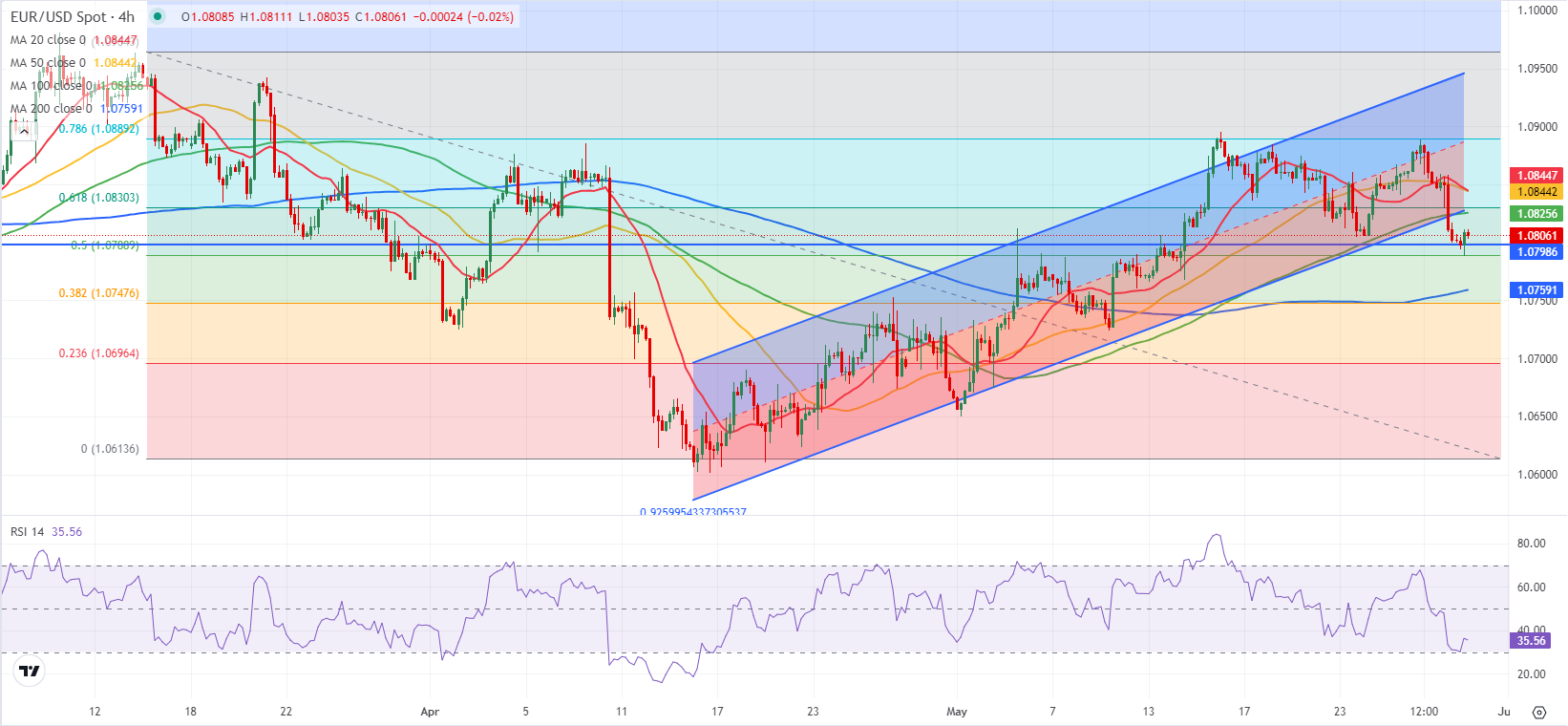- EUR/USD holds steady near 1.0800 following Wednesday's sharp decline.
- A daily close below 1.0790 could attract technical sellers.
- US Bureau of Economic Analysis will release the second estimate of Q1 GDP.
EUR/USD came under heavy bearish pressure in the American session on Wednesday and closed the day deep in negative territory as safe-haven flows dominated the action in financial markets. After dipping to its lowest level in two weeks below 1.0800 in the Asian session on Thursday, the pair recovered back above 1.0800.
Euro PRICE This week
The table below shows the percentage change of Euro (EUR) against listed major currencies this week. Euro was the weakest against the Swiss Franc.
| USD | EUR | GBP | JPY | CAD | AUD | NZD | CHF | |
|---|---|---|---|---|---|---|---|---|
| USD | 0.37% | 0.30% | 0.00% | 0.41% | 0.32% | 0.25% | -0.49% | |
| EUR | -0.37% | -0.10% | -0.32% | 0.04% | -0.12% | -0.22% | -0.83% | |
| GBP | -0.30% | 0.10% | -0.28% | 0.12% | -0.00% | -0.05% | -0.76% | |
| JPY | 0.00% | 0.32% | 0.28% | 0.35% | 0.28% | 0.32% | -0.54% | |
| CAD | -0.41% | -0.04% | -0.12% | -0.35% | -0.10% | -0.16% | -0.96% | |
| AUD | -0.32% | 0.12% | 0.00% | -0.28% | 0.10% | -0.02% | -0.75% | |
| NZD | -0.25% | 0.22% | 0.05% | -0.32% | 0.16% | 0.02% | -0.75% | |
| CHF | 0.49% | 0.83% | 0.76% | 0.54% | 0.96% | 0.75% | 0.75% |
The heat map shows percentage changes of major currencies against each other. The base currency is picked from the left column, while the quote currency is picked from the top row. For example, if you pick the Euro from the left column and move along the horizontal line to the US Dollar, the percentage change displayed in the box will represent EUR (base)/USD (quote).
Following Tuesday's decline, Wall Street's main indexes opened lower on Wednesday and continued to push lower. The Dow Jones Industrial Average lost over 1% on the day and the S&P 500 fell 0.75%. The US Dollar (USD) capitalized on risk aversion, with the USD Index reaching its highest level since May 14 above 105.00.
Early Thursday, US stock index futures are down between 0.5% and 0.8%, suggesting that markets could remain risk-averse in the second half of the day.
The US Bureau of Economic Analysis (BEA) will release its second estimate of the Gross Domestic Product (GDP) for the first quarter. In the initial estimate, the BEA announced that the US' GDP expanded at an annual rate of 1.6%. Markets expect a downward revision to 1.3% in the second estimate. In case there is a bigger downward revision, the USD could struggle to find demand, even if US stocks stay in the red. On the other hand, a better-than-forecast print could support the USD and weigh on EUR/USD.
The US economic docket will also feature weekly Initial Jobless Claims data. A reading near 200K could provide a boost to the USD, while an unexpected increase toward 230K could hurt the USD.
EUR/USD Technical Analysis
EUR/USD dropped below the lower limit of the ascending regression channel and the Relative Strength Index (RSI) indicator on the 4-hour chart fell below 40, highlighting a bearish tilt in the near term.
The 200-day Simple Moving Average (SMA) aligns as key support at 1.0790. In case the pair makes a daily close below that level and starts using it as resistance, technical sellers could remain interested. In this scenario, 1.0760-1.0750 (200-period SMA on the 4-hour chart, Fibonacci 38.2% retracement of the latest downtrend) could be seen as next support before 1.0700 (psychological level, Fibonacci 23.6% retracement).
Risk sentiment FAQs
In the world of financial jargon the two widely used terms “risk-on” and “risk off'' refer to the level of risk that investors are willing to stomach during the period referenced. In a “risk-on” market, investors are optimistic about the future and more willing to buy risky assets. In a “risk-off” market investors start to ‘play it safe’ because they are worried about the future, and therefore buy less risky assets that are more certain of bringing a return, even if it is relatively modest.
Typically, during periods of “risk-on”, stock markets will rise, most commodities – except Gold – will also gain in value, since they benefit from a positive growth outlook. The currencies of nations that are heavy commodity exporters strengthen because of increased demand, and Cryptocurrencies rise. In a “risk-off” market, Bonds go up – especially major government Bonds – Gold shines, and safe-haven currencies such as the Japanese Yen, Swiss Franc and US Dollar all benefit.
The Australian Dollar (AUD), the Canadian Dollar (CAD), the New Zealand Dollar (NZD) and minor FX like the Ruble (RUB) and the South African Rand (ZAR), all tend to rise in markets that are “risk-on”. This is because the economies of these currencies are heavily reliant on commodity exports for growth, and commodities tend to rise in price during risk-on periods. This is because investors foresee greater demand for raw materials in the future due to heightened economic activity.
The major currencies that tend to rise during periods of “risk-off” are the US Dollar (USD), the Japanese Yen (JPY) and the Swiss Franc (CHF). The US Dollar, because it is the world’s reserve currency, and because in times of crisis investors buy US government debt, which is seen as safe because the largest economy in the world is unlikely to default. The Yen, from increased demand for Japanese government bonds, because a high proportion are held by domestic investors who are unlikely to dump them – even in a crisis. The Swiss Franc, because strict Swiss banking laws offer investors enhanced capital protection.
Information on these pages contains forward-looking statements that involve risks and uncertainties. Markets and instruments profiled on this page are for informational purposes only and should not in any way come across as a recommendation to buy or sell in these assets. You should do your own thorough research before making any investment decisions. FXStreet does not in any way guarantee that this information is free from mistakes, errors, or material misstatements. It also does not guarantee that this information is of a timely nature. Investing in Open Markets involves a great deal of risk, including the loss of all or a portion of your investment, as well as emotional distress. All risks, losses and costs associated with investing, including total loss of principal, are your responsibility. The views and opinions expressed in this article are those of the authors and do not necessarily reflect the official policy or position of FXStreet nor its advertisers. The author will not be held responsible for information that is found at the end of links posted on this page.
If not otherwise explicitly mentioned in the body of the article, at the time of writing, the author has no position in any stock mentioned in this article and no business relationship with any company mentioned. The author has not received compensation for writing this article, other than from FXStreet.
FXStreet and the author do not provide personalized recommendations. The author makes no representations as to the accuracy, completeness, or suitability of this information. FXStreet and the author will not be liable for any errors, omissions or any losses, injuries or damages arising from this information and its display or use. Errors and omissions excepted.
The author and FXStreet are not registered investment advisors and nothing in this article is intended to be investment advice.
Recommended Content
Editors’ Picks

GBP/USD clings to recovery gains above 1.2650 after UK data
GBP/USD clings to recovery gains above 1.2650 in European trading on Friday. The mixed UK GDP and industrial data fail to deter Pound Sterling buyers as the US Dollar takes a breather ahead of Retail Sales and Fedspeak.

EUR/USD rises to near 1.0550 after rebounding from yearly lows
EUR/USD rebounds to near 1.0550 in the European session on Friday, snapping its five-day losing streak. The renewed upside is mainly lined to a oause in the US Dollar rally, as traders look to the topt-tier US Retail Sales data for a fresh boost. ECB- and Fedspeak also eyed.

Gold defends key $2,545 support; what’s next?
Gold price is looking to build on the previous rebound early Friday in search of a fresh impetus amid persistent US Dollar buying and mixed activity data from China.

Bitcoin to 100k or pullback to 78k?
Bitcoin and Ethereum showed a modest recovery on Friday following Thursday's downturn, yet momentum indicators suggest continuing the decline as signs of bull exhaustion emerge. Ripple is approaching a key resistance level, with a potential rejection likely leading to a decline ahead.

Trump vs CPI
US CPI for October was exactly in line with expectations. The headline rate of CPI rose to 2.6% YoY from 2.4% YoY in September. The core rate remained steady at 3.3%. The detail of the report shows that the shelter index rose by 0.4% on the month, which accounted for 50% of the increase in all items on a monthly basis.

Best Forex Brokers with Low Spreads
VERIFIED Low spreads are crucial for reducing trading costs. Explore top Forex brokers offering competitive spreads and high leverage. Compare options for EUR/USD, GBP/USD, USD/JPY, and Gold.
